Famous for the upside-down posture, Upside down catfish is an easy to care species even beginners can keep.
Unlike other catfish that feed on the bottom, this species feed from the water’s surface.
Also known as the blotched upside-down catfish, their history goes back to ancient Egypt because of their unique appearance.
Here in this article, you’ll learn everything about Upside Down Catfish and their care needs.
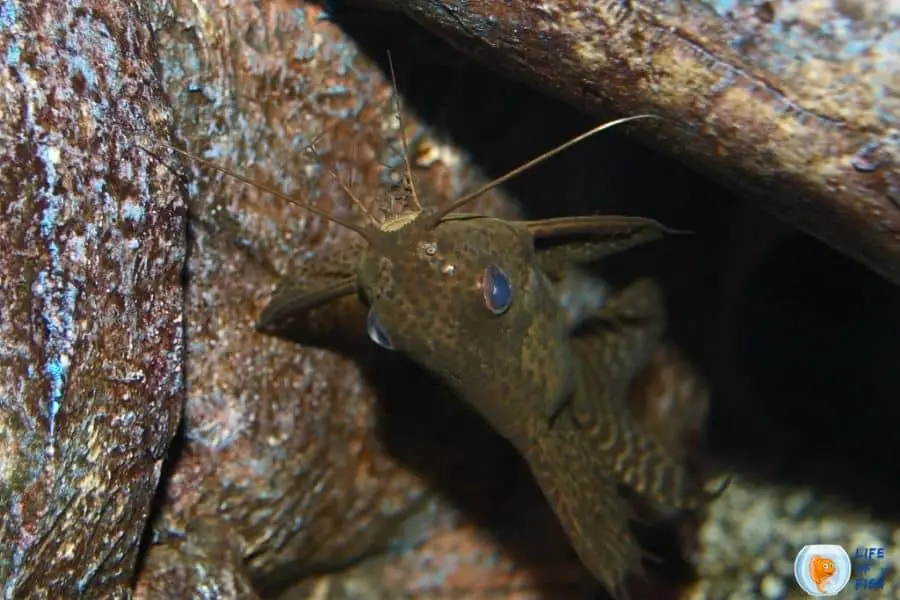
What is Upside Down Catfish?
Jump To
- 1 What is Upside Down Catfish?
- 2 How big do Upside Down Catfish get?
- 3 One look care guide
- 4 How they look like?
- 5 Is Upside Down Catfish aggressive?
- 6 Upside Down Catfish behavior
- 7 How long do Upside Down Catfish live?
- 8 Upside Down Catfish care
- 9 Upside Down Catfish breeding
- 10 Special tips
- 11 How to feed Upside Down Catfish?
- 12 What fish can live with Upside Down Catfish?
- 13 Upside Down Catfish Diseases
- 14 Related questions
Upside Down Catfish are unique freshwater species native to Central Africa.
Unlike typical tropical fish, these species exhibit some strange behavior. Rather than swimming upright, these fish swim upside down.
Further, they feed on the surface of the water, unlike other catfish species.
Although there are several species known as upside-down catfish, the species specifically popular in the aquarium trade is Synodontis nigriventris.
You can find them in the Congo River basin all over Kinsasha, Basonga, and Cameroon. They inhabit densely vegetated areas and near the banks of rivers.
Though the usual behavior of these fish is to swim upside down, they may also swim right side up sometimes to graze from the bottom of the tank.
Scientists have found out that they have a normal swim bladder and a balancing organ in the ear like any other catfish. But, these specific species choose to behave that way.
These fish are quite popular among aquarists around the world because of their eye-catching behavior, ease of care, and peaceful temperament.
However, many specimens sold at aquarium shops are wild-caught ones, not captive-bred.
How big do Upside Down Catfish get?
On average, upside-down catfish grow up to 3 to 4 inches in length.
They are on the smaller side than the other catfish species, which can be advantageous for aquarists who own smaller aquariums.
The size of these fish can vary due to the aquarium conditions. If kept in optimum conditions, they will reach their maximum size easily.
But, if you keep them in poor water conditions, they may not get their average size as expected.
One look care guide
| Scientific name | Synodontis nigriventris |
| Family | Mochokidae |
| Common name | Upside-down catfish blotched upside-down catfish |
| Care level | Easy |
| Native to | Central Africa |
| Type | Freshwater Fish |
| Color | light brown with dark brown blotches of various sizes |
| Tank size | 10 gallons minimum, 30 gallons optimum |
| Preferred temperature | 72°F to 82°F (ideal temperature 75 – 79 F) |
| Other water parameters | pH level: 6.0 – 7.5 Water hardness: 4 – 15 DGH Ammonia: 0 Nitrite:s 0 |
| Preferred salinity | No salinity |
| Size | 3-4 inches |
| Life Span | Five years |
| Temperament | Peaceful |
| Recommended tank mates | Similar sized non-aggressive species, Avoid aggressive species and small fish E.g.: Apistogramma, Pelvicachromis, and Anomalochromis (aka Dwarf Cichlids)Small Elephantfish, Congo Tetra, African tetras, African Butterfly Fish |
| Preferred food | Catfish pellets Algae wafers Algae Mosquito larvae Worms Brine shrimp Freeze-dried bloodworms Tubifex Frozen and fresh bloodworms Blackworms |
| Feeding frequency | Two times per day |
| Breeding | Difficult, cave spawners, egg layers |
How they look like?
Upside-down catfish are light brown with dark brown blotches of various sizes. This color variation helps them to camouflage in their surroundings.
Like any other catfish, they also have large eyes, a forked tail, a large adipose fin, and three pairs of barrels.
The fins may be flattened when they swim but pop up when they feel threatened.
They also have sharp spines on their semi-transparent fins that can harm other fish and humans when entangled.
However, they only entangle these spines if they feel threatened. So, when handling them, use a very fine mesh to avoid injuries.
One of the unique features of upside-down catfish is their underbelly.
They have a dark brown underbelly to closely match their backs which helps them camouflage when they swim upside-down.
But, in many other fish species, the underbelly is lighter than the rest of the body.
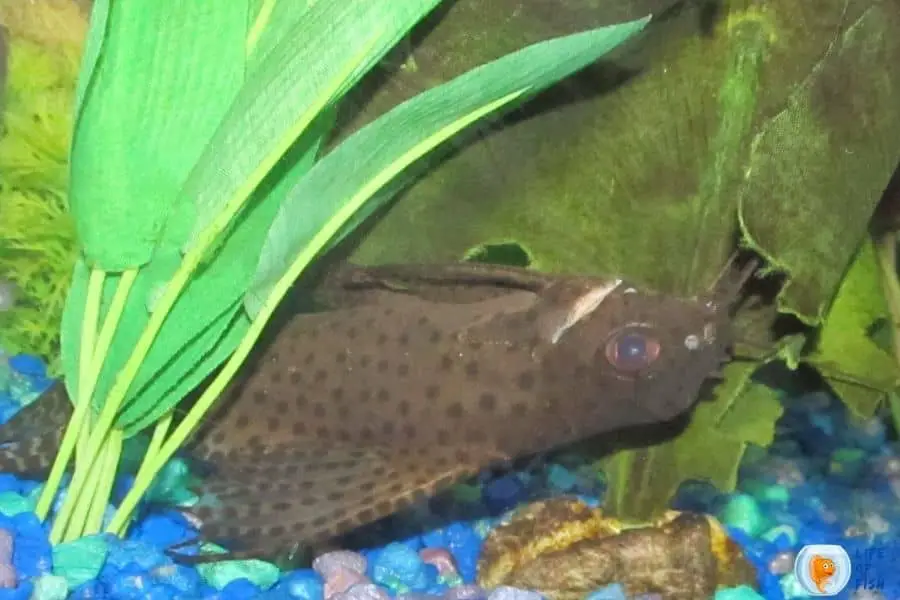
Is Upside Down Catfish aggressive?
No. Upright down catfish are very peaceful species that can live with any other non-aggressive fish species.
They are nocturnal fish that mostly stay hidden during the day. So, most of the time, they mean no harm for diurnal species.
Upside Down Catfish behavior
Upside down catfish are nocturnal species. They mostly become active at night and stay hidden during day time.
When the sun sets, these fish come out of their hiding places and explore around the tank.
Unlike other catfish species that stay on the bottom all the time, upside-down catfish are very active swimmers that swim everywhere, in every part of the water column.
Since these are peaceful fish, they can get along with other non-aggressive species very easily.
They are shy if they live in solitary. But when kept in groups, these fish get more confident and social.
You may even find them exploring around during the daytime if kept in groups. If not, they will spend their daytime hiding behind rocks, driftwood, and caves.
Despite their name, upside-down catfish can swim both in an upright position and upside-down position.
However, they are faster and more comfortable when they swim upside-down. They will often stay still for a long time without moving and will go to the water’s surface to find food.
How long do Upside Down Catfish live?
Upside-down catfish can live up to 5 years in optimum water conditions. However, this may change due to several reasons.
Upside Down Catfish care
Although these fish are mostly wild-caught ones, they can adapt well in the aquarium environment.
Upside-down catfish are hardy and easy to care for. But, knowing their optimum conditions and preferences can increase their health and life expectancy.
Upside Down Catfish size
Upside-down catfish can grow about 3 to 4 inches maximum, making them a perfect choice for nano aquariums.
Upside Down Catfish tank size
Upside-down catfish can live in nano aquariums as small as 10 gallons. But, as we always say, the more space, the better.
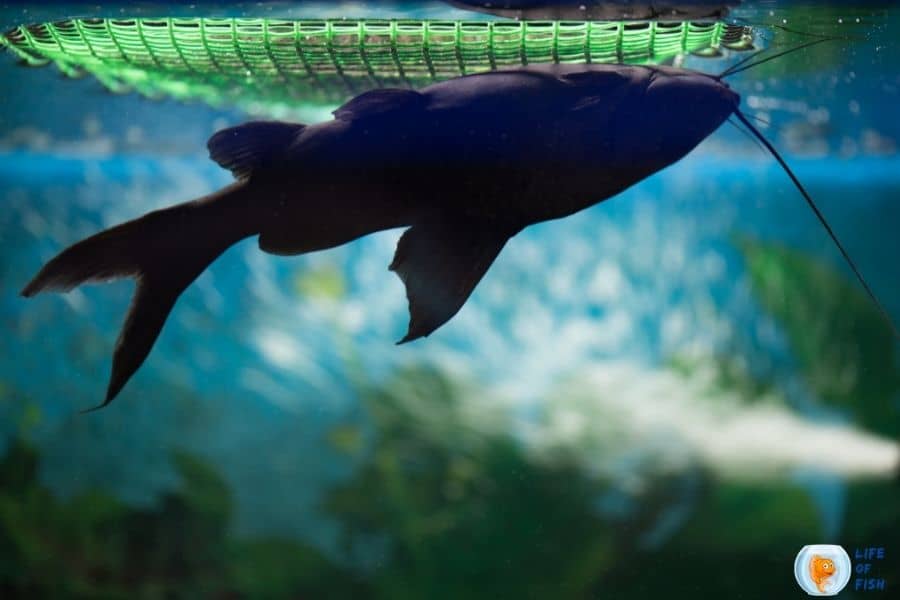
How many Upside Down Catfish should be kept together?
You can keep only one fish if you prefer but be prepared not to see it all the time because solitary increases their stress, so they will hide most of their time.
The recommended amount of fish per tank is about 3 to 4 fish. When kept in groups, they become more social and confident, so they will more likely come outside during the day.
Tank setup
The minimum tank size recommended for these species is 10 gallons. But, if you can provide a 30-gallon tank, that is better.
Since these fish are used to live in densely vegetated areas in the wild, you need to provide similar habitat in your aquarium.
Make sure that your tank is well-planted, preferably with broad-leafed plants, and filled with several hiding places such as driftwood, rock arches, caves, and rockwork decorations.
Anubias, Echinodorus, and other emergent plants are good choices. These fish are generally hiding underside of their hiding places.
So, be sure to offer multiple underneath surfaces that are large enough to accommodate the fish group at once.
Large pieces of driftwood and large-sized caves are excellent choices as hiding spots.
Another essential thing to consider is water flow. Upside-down catfish prefer strong flow in their surroundings.
They’re tough and will utilize their lips to latch onto whatever they’re eating. To provide a strong water flow, use a water pump or a hang-on-back filter.
These creatures require highly oxygenated water. Therefore we recommend installing an air bladder or bubbler along with a good water filter in your tank.
Water quality condition
The native waters of these fish aren’t much different from tropical waters in Asia and South America.
So, upside-down catfish also prefer warmer waters in their surroundings. However, unlike other tropical fish, upside-down catfish need moderately soft and relatively neutral water.
So, you have to pay attention to the pH and Hardness level of the water.
The recommended parameters for these species are,
- Water temperature: 72°F – 82°F (ideal temperature 75 – 79 F)
- pH level: 6.0 – 7.5
- Water hardness: 4 – 15 dGH
These creatures are susceptible to Ammonia and Nitrite levels. So, if you have a community tank, you may have to clean it often to keep these impurities level down.
We recommend performing a 25% water change every two weeks to keep things in order. Additionally, you should install a HOB filter or a canister filter for filtering water.
Upside Down Catfish breeding
Breeding upside-down catfish is somewhat tricky. Most fish sold at stores are either wild-caught ones or bred using reproductive hormones.
However, a limited number of aquarists successfully bred these fish in captivity. But, most of them were a hit or miss.
Upside Down Catfish male or female identification
Female color is on the dull side, and they are more rounder than male fish. Male fish is lean and brighter than the female upside-down catfish.
Upside Down Catfish breeding
Upside-down catfish are egg-laying fish that generally lays their eggs on the roof of caves.
So, you will have to provide a suitable spawning spot for these fish. Some appropriate choices are overturned-clay flower pots, large caves, or long PVC pipes.
They usually spawn in the Spring while raining. So, you will have to mimic these conditions by cooling the water and adding a water sprinkler to the tank.
Before adding these fish to the breeding tank, condition the fish by feeding them with live foods.
You may not have to separate males from females as they usually pair off when conditions are ideal.
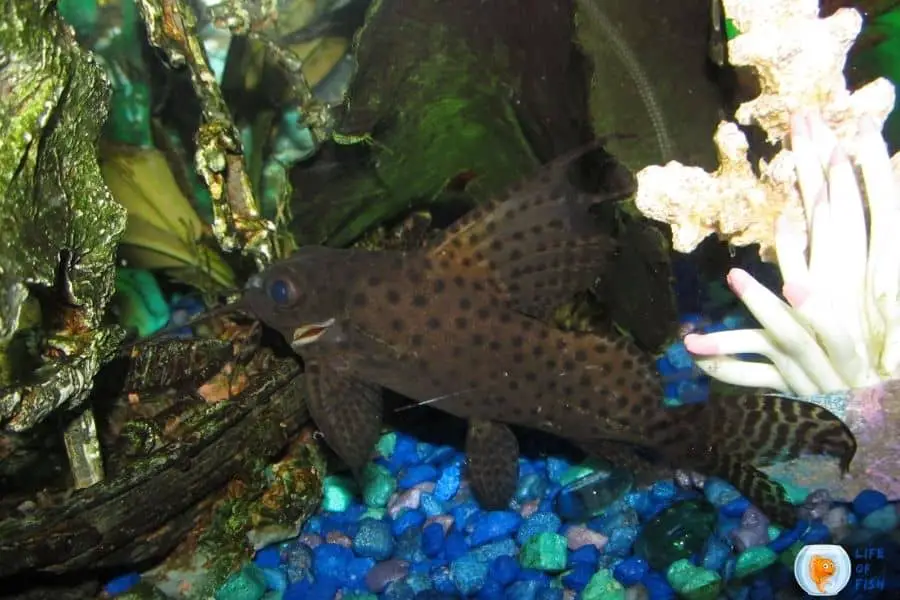
How many babies do Upside Down Catfish have?
Upside-down catfish usually lays about 450 eggs at one spawning season.
Upside Down Catfish fry care
Caring for upside-down catfish is easy because you don’t need to separate them from their parents.
Unlike South American Corydoras catfish, both upside-down catfish parents tend to brood the eggs. The eggs take about two to three days to hatch.
During their first four days, they will feed off the yolk sac. Then, you will have to feed them with freshly hatched baby brine shrimp.
They begin swimming upright before transitioning to the typical inverted position. After two months, the fry will start swimming in the usual upside-down manner.
Special tips
Always house these fish in groups to avoid stress and unwanted health problems.
Be extra careful while handling these fish because of their sharp fin spines that can hurt you. The suitable net is a “very fine” one.
How to feed Upside Down Catfish?
Upside down catfish are omnivores. They primarily feed on insects at the water’s surface.
They also scavenge food like worms, insects, and microorganisms under driftwood, caves, and pipes. Sometimes these fish graze on algae to supplement their diet.
In aquariums, these fish readily eat anything you provide without hesitating.
You can feed them with catfish pellets, freeze-dried bloodworms, tubifex, frozen and fresh bloodworms, and blackworms.
For optimum health, offer more meaty food like insect larvae and mosquito larvae when possible.
When you feed them with live foods at the water’s surface, they will accept it all the time.
Supplement their diet with vegetables like peas and cucumber, even if they eat algae off your aquarium.
What fish can live with Upside Down Catfish?
Upside down catfish are friendly and peaceful fish species that can be combined with many other peaceful fish species.
However, it is wise to avoid smaller fish as they may become prey to these fish.
It is better to keep them in a small school so that they will be more socialized and come out of their hiding places in the daytime.
Never house these fish with aggressive fish species. It’s not that aggressive fish will harm them but will be otherwise.
Upside-down catfish have a defense mechanism to save themselves from the enemies.
They have spines that entangle when they are threatened, and these spines may become lodged in the predator’s throat, harming them.
Here are some suitable tank mates for upside-down catfish.
- Apistogramma, pelvicachromis, and anomalochromis (aka Dwarf Cichlids)
- Small Elephantfish
- Congo Tetra
- African tetras
- African Butterfly Fish
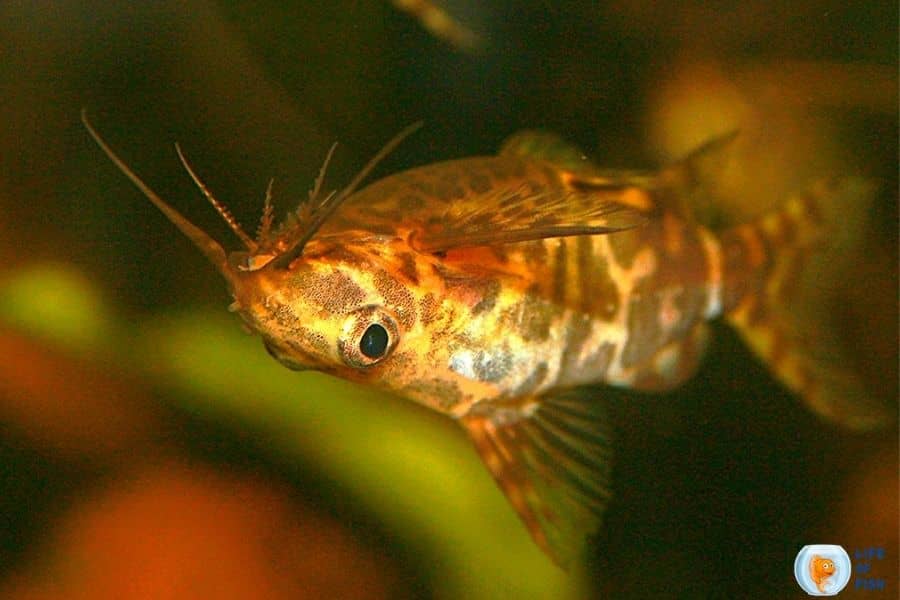
Upside Down Catfish Diseases
Many people believe that their quirky behavior is a health issue. But actually, it is not.
Ichthyologists have examined their internal organs and found out that there is no issue with their swim bladder or balance mechanism.
All organs function just like other catfish species. It’s just that this species adapted to swim upside-down.
Upside down catfish are generally healthy fish comparing to other fishes. However, they also are prone to tropical fish diseases such as Ich or bacterial infections.
One common disease of these species is barbel infections. The reason for this disease is high concentrations of Nitrites in the water.
If you keep these impurities level down, you can avoid infected barbels and many other diseases.
Related questions
Will upside-down catfish eat other fish?
Although they are peaceful fish, they still are carnivore fish species. So, yes. They will eat other fish if the fish are small enough for their mouth.
Is it normal for a fish to swim upside down?
Despite oddball fish like upside-down catfish and lionfish, swimming upside-down is considered to be a cause for concern. Usually, fish swim this way if there is an issue with the swim bladder. It is a symptom of various diseases, so you may need to check for the underlined condition of your fish if it swims upside-down.
Do upside-down catfish sleep?
Yes. Like any other fish, these fish also go to sleep at some time. It is rather noticeable when they go to sleep because they turn upside-down ( which means upright position) and stay still. Since they are not moving, they will float when asleep, and you may misjudge them for dead fish while actually, they are not.
How long does an Upside Down Catfish live?
Upside–down catfish can live for about five years under optimum care conditions.
Read Next: Wonderful Stargazer Fish | 15 Things You Should Know About |
